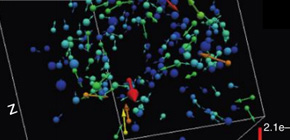
Rheological properties of high-density glass demonstrated on numerical simulations by a supercomputer
Specially Appointed Researcher Yuliang Jin and Professor YOSHINO Hajime at the Cybermedia Center, Osaka University verified that once glass was compressed above the so-called Gardner transition density, complex free-energy landscapes occurred (i.e., the elasticity broke down,) and the stress relaxation exhibited slow and ageing dynamics, a world first.
When rapidly cooled or compressed, a liquid forms not a crystal but a glass (amorphous solid), which is seen both in nature and in industrial products such as window glass. Glass is hard and a solid like quartz. However, in quartz, molecules and atoms are arranged in a regular grid, while glass has a random, disordered arrangement like a liquid.
Recent theoretical advances predict the existence of the Gardner transition. Once glass is compressed up to a certain density (above the so-called Gardner transition density), the elasticity breaks down and complex free-energy landscapes occur. Further compression yields a jammed state that is regarded as the infinite-pressure limit of glassy state. It is also predicted that the Gardner transition takes place before reaching the jammed state.
By using densely packed hard sphere glasses formed by compression to a high density, this group compared elasticity in the two protocols, (1) zero-field cooling (ZFC) protocol: after compression, the shear strain was applied, (2) field cooling (FC) protocol: after applying the shear strain, compression was applied.
As a result, it was found that the difference between the ZFC and FC magnetizations emerged at pressures beyond the critical pressure. This means that compression of a glassy state causes a complex free energy landscape, creating protocol-dependent shear modulus: a low shear modulus in the ZFC protocol and a high modulus in the FC protocol.
It is anticipated this group’s achievement will promote the understanding of a variety of glasses (amorphous solids) and contribute to the development of glass physics and material engineering.
Abstract
For amorphous solids, it has been intensely debated whether the traditional view on solids, in terms of the ground state and harmonic low energy excitations on top of it, such as phonons, is still valid. Recent theoretical developments of amorphous solids revealed the possibility of unexpectedly complex free energy landscapes where the simple harmonic picture breaks down. Here we demonstrate that standard rheological techniques can be used as powerful tools to examine non-trivial consequences of such complex free energy landscapes. By extensive numerical simulations on a hard sphere glass under quasi-static shear at finite temperatures, we show that, above the so-called Gardner transition density, the elasticity breaks down, the stress relaxation exhibits slow and aging dynamics, and the apparent shear modulus becomes protocol-dependent. Being designed to be reproducible in laboratories, our approach may trigger explorations of the complex free energy landscapes of a large variety of amorphous materials.
Figure 1
Figure 2
Figure 3
To learn more about this research, please view the full research report entitled " Exploring the complex free energy landscape of the simplest glass by rheology " at this page of the Nature Communications website.
Related link
